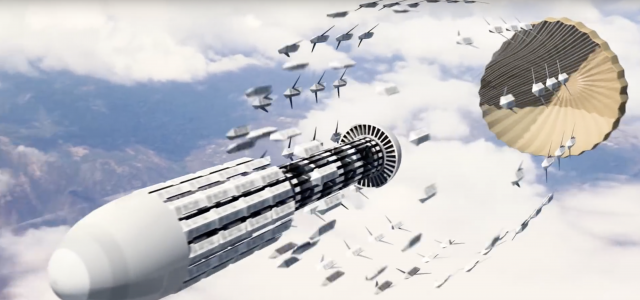This is a cool piece from Popular Mechanics by Joe Pappalardo
An F-35A fighter plane cuts across the sky, dead-set on destroying an enemy bunker protected by a network of radar and antiaircraft missile batteries. A flock of wingmen tag along to help the pilot defeat these defenses. But none of those companion planes have a person inside. They are semi-autonomous drones the pilot must trust with his life.
This scenario can be seen in a recently released “Call to Action” video made by the Air Force Research Lab. Nominally a look at what the U.S. Air Force will be like in 2030, the clip is also a plea by Secretary of the U.S. Air Force Heather Wilson, who last year launched an initiative to upgrade the Air Force’s science and technology strategy.
The idea of a piloted plane acting as mothership to a flock of unmanned aerial vehicles is not new. In 2010, we ran a cover story about the unmanned aircraft supporters inside the Pentagon. The hypothetical combat scenario in that article is reminiscent of the scene played out in the Air Force video, in which drones take on dangerous mission in the suppression of enemy air defenses, or (SEAD). Here’s how a robot-enhanced mission could unfold.
The lead UAV puts itself in harm’s way as it flies into radar range of antiaircraft missile batteries. An icon on the F-35 pilot’s virtual head-up display, projected onto the faceplate of his helmet, alerts him that the lead drone has automatically identified the emissions of an enemy radar site. This is the first time in the mission that the SEAD airplane has communicated with any human.
Miles from the danger, the F-35A pilot coolly assesses the situation, confirms the target is legitimate, and authorizes the lead UAV to open fire. The drone’s AGM-88 high-speed anti-radiation missile follows the radar waves back to their source, obliterating the dish and its crew. There is now a gap in the enemy radar screen, and the pilot directs the UAV to return to base.
Meanwhile, another UAV is flying east of the target, navigating via a mix of GPS and accelerometer data. This aircraft is busy scrambling other enemy radar installations by flooding the skies with emissions that share the radar’s frequency. The jamming pods under the UAV’s wings also disrupt radio transmissions from the air-defense network, covering up the sudden loss of contact with the radar sites protecting the bunker. Otherwise, an enemy commander could discover the location of the actual raid. After a preset amount of time spreading confusion, the UAV returns to base.
The F-35A pilot is closing in on the target, fast. He needs to aim the F-35’s electro-optical targeting system to release a bomb that will hit the structure at a precise angle calculated to collapse it without destroying nearby civilian buildings. He triggers the laser designator and authorizes the nearby unmanned airplane to drop a pair of bombs, which use fins to steer toward the laser-targeted sweet spot.
The pilot watches the twin, concurrent explosions, makes a quick battle-damage assessment and, satisfied, banks the airplane and heads back to base. His robotic wingman follows his lead, flying evenly at his side.
By Joe Pappalar



















